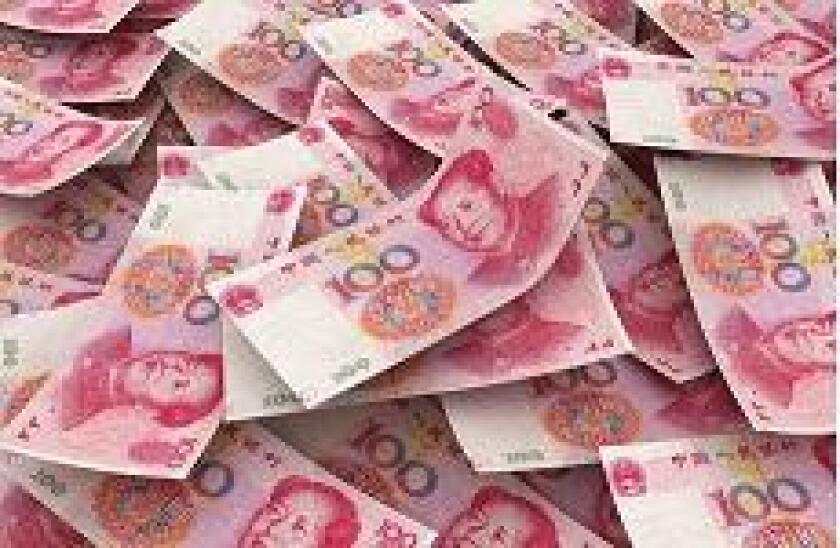It has been a slow year for the CNH market in 2015. According to GlobalRMB, a total of 40 deals have raised just Rmb47bn ($7.7bn) so far this year, including the Rmb14bn ($2.26bn) sold by China’s Ministry of Finance on Wednesday and taking into account a hefty increase in Formosa bond issuance.
This is a big decline from the same period in 2014, when issuers had bagged Rmb105bn ($16.94bn) from 60 deals. Tight liquidity and high cross currency swap (CCS) rates were to blame, as they increased the cost of holding dim sum bonds, creating selling pressure.
However, Zhengzhou Yutong Group finally broke the dim sum bond hiatus on May 20 when it raised Rmb1bn ($161m) from its debut 4% five year . On the same day, The Chinese Ministry of Finance (MoF)’s auction of Rmb14bn ($2.3bn) of bonds across six tenors attracted Rmb36.2bn ($5.842bn) of demand (see separate story). It was followed by Chinese brokerage Southwest Securities, which started taking bids for its debut dim sum trade the next day.
“This [more CNH issuance] will definitely be a trend for a while,” said a Hong Kong based syndicate banker. “The Chinese government has been very actively injecting liquidity in the market to boost its economy, so there is plenty of cash floating around.”
Earlier this month, the People’s Bank of China (PBoC) cut interest rates, lowering its benchmark one year lending rate by 25bp to 5.1% and cutting the benchmark deposit rate by the same amount, to 2.25%. It also lowered the reserve requirement ratio (RRR) in February and April.
“The Chinese government is opening up more channels and relaxing the eligibility criteria for Chinese individuals to invest in Hong Kong, which has increased CNH liquidity,” said a Hong Kong based syndicate banker.
The China Securities Regulatory Commission (CSRC) on March 27 released a set of guidelines for local mutual funds to participate in Shanghai-Hong Kong Stock Connect, meaning existing and new funds are allowed to expand their investment scope into Hong Kong stocks without having a qualified domestic institutional investor (QDII) licence and quota.
This set of looser monetary policies has certainly helped money flow southbound. Since November 2014 — when Stock Connect launched — until mid-March this year, around Rmb110bn ($17.75bn) of money drained from Hong Kong into China, according to CEIC data. But by May 15 the data showed that the liquidity drain had been reversed, with net outflows of Rmb30bn ($4.84bn).
Tighter spread in secondary
Yet despite growing demand and liquidity, there has not been much primary issuance in CNH lately. The last dim sum bond before Yutong was issued on April 28, when China New Town Development sold Rmb1.3bn ($210m) of 5.5% 2018s.
This was evident in the tightening of dim sum bond second market prices. Aa3 rated Shenzhen Qianhai’s debut bond, which priced on April 21 at par to yield 4.55%, was seen on May 20 at 3.9%. This encouraged banks on the A1 rated Yutong deal, although a lower-rated credit, to start with initial guidance of 4.3%.
“The big mismatch between supply and demand in CNH has pushed the secondary market to go a lot tighter this month, by 25bp-50bp on average, and it provides a good opportunity for issuers who want to save on cost,” a Hong Kong based syndicate banker said. The banker noted that the new Yutong bond, priced at 4%, was trading at 3.86% on its first day.
“The tighter spread will definitely lure more issuers to CNH who want to take advantage of lower yield environment,” the banker said.
And while market analysts acknowledge that onshore borrowing costs have become cheaper since the PBoC cut rates, this is seen as unlikely to hurt the revival in offshore renminbi bonds.
“Borrowing onshore has actually become cheaper as a result, and onshore versus offshore is around 15bp cheaper, which is not much,” said a Hong Kong based analyst. “There are still many other benefits if you go for offshore renminbi.”
He said that for companies — both Chinese and non-Chinese — who run operations in Hong Kong and overseas, CNH has become an increasingly attractive option in that it provides opportunities to expose their brands to the international capital market and diversify into a new investor base.
Real money demand
Zhengzhou Yutong’s bond, issued by wholly owned subsidiary Sinostrong International, was a testament to a changing perception of dim sum bonds by investors, according to a banker on the trade.
“What’s interesting about Yutong is, if we look at the investor split, the notes were subscribed by a lot of real demand — fund managers — especially when compared to Shenzhen Qianhai ,” the banker said.
Fund managers took 58% of the Yutong trade, followed by banks on 37%, and private banks and securities on 5%. For Qianhai , banks bought 43% and fund managers/corporates accounted for 24%.
“One of the biggest hurdles to accessing the CNH market was the volatility in the CCS rates, and now that FX has been stabilised and liquidity is back, real money managers, not just from Taiwan but also Hong Kong and Singapore, are getting more confident about putting their money in dim sum bonds,” the banker added.
The debut notes from the unrated borrower came with a standby letter of credit (SBLC) from A1/A/A rated Bank of China’s Macau branch, which was behind Moody’s A1 rating on the notes.
The leads revised guidance at 3pm Hong Kong time to 4.05%, before pricing the bond at par to yield 4% at 5:30pm. The company raised Rmb1bn, as approved under the terms of the SBLC. The order book reached Rmb6bn ($968m) from 101 accounts.
